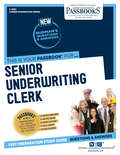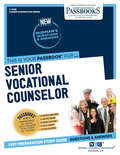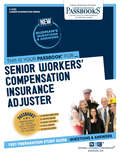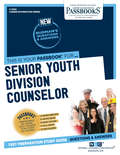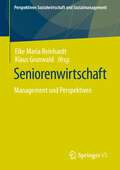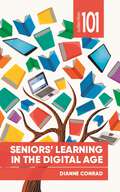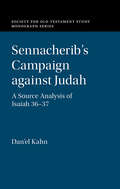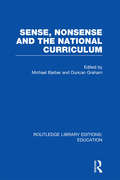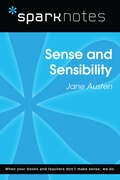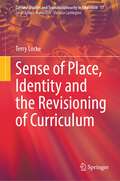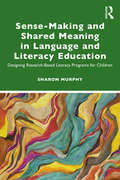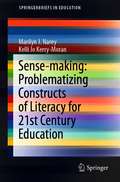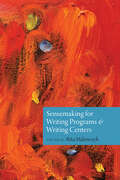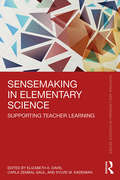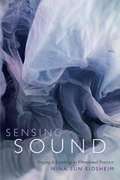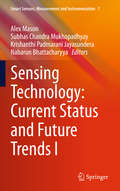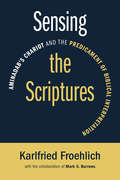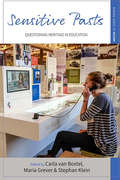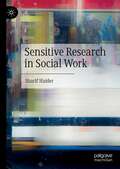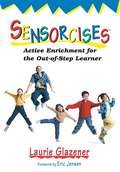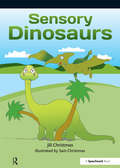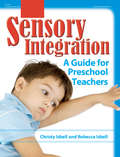- Table View
- List View
Senior Underwriting Clerk: Passbooks Study Guide (Career Examination Series)
by National Learning CorporationThe Senior Underwriting Clerk Passbook® prepares you for your test by allowing you to take practice exams in the subjects you need to study. It provides hundreds of questions and answers in the areas that will likely be covered on your upcoming exam, including but not limited to: Clerical aptitude; Arithmetic; Understanding and interpreting written material; Organizing data into tables and charts; and more.
Senior Vocational Counselor: Passbooks Study Guide (Career Examination Series)
by National Learning CorporationThe Senior Vocational Counselor Passbook® prepares you for your test by allowing you to take practice exams in the subjects you need to study. It provides hundreds of questions and answers in the areas that will likely be covered on your upcoming exam, including but not limited to; Problems of the economically disadvantaged, the unemployed, and the underemployed; Interviewing; Counseling; Employment counseling; Supervision; and more.
Senior Workers' Compensation Claims Adjuster: Passbooks Study Guide (Career Examination Series)
by National Learning CorporationThe Senior Workers' Compensation Claims Adjuster Passbook® prepares you for your test by allowing you to take practice exams in the subjects you need to study. It provides hundreds of questions and answers in the areas that will likely be covered on your upcoming exam.
Senior Workers' Compensation Insurance Representative: Passbooks Study Guide (Career Examination Series)
by National Learning CorporationThe Senior Workers' Compensation Insurance Representative Passbook® prepares you for your test by allowing you to take practice exams in the subjects you need to study. It provides hundreds of questions and answers in the areas that will likely be covered on your upcoming exam, including but not limited to: reading and understanding reports, rules and regulations, and other materials based on the workers' compensation law; applying written and tabular material; preparing various written materials and forms; arithmetic calculations; knowledge of basic medical terms; and other related areas.
Senior Youth Division Counselor: Passbooks Study Guide (Career Examination Series)
by National Learning CorporationThe Senior Youth Division Counselor Passbook® prepares you for your test by allowing you to take practice exams in the subjects you need to study. It provides hundreds of questions and answers in the areas that will likely be covered on your upcoming exam, including but not limited to: counseling; administering and supervising a youth counseling program in a community setting or a facility for the rehabilitation of court adjudicated youth; case work and counseling techniques; adolescent behavior; identifying and analyzing client needs; design and implement treatment plans; and other related areas.
Senior, Class of '88 (Class of '88, #4)
by Linda A. CooneyFive friends. Nick the golden boy, Celia the beautiful, Sean the thinker, Allie the wild, Meg the brave. Meg and Nick have stayed away from each other for four years. Finally they want to be together... and someone's stopping them. Celia andAllie are trying to be friends again. But they both have a date for the prom-with the same guy. Sean is a BMOC and valedictorian, yet he still wants revenge for freshman year. In high school they lost some hopes, some dreams, some fears. Now they have to hold on to the one thing they've got left-each other.
Seniorenwirtschaft: Management und Perspektiven (Perspektiven Sozialwirtschaft und Sozialmanagement)
by Klaus Grunwald Elke Maria ReinhardtDer Band skizziert Seniorenwirtschaft als einen vielfältigen Bereich des Wirtschaftens, der sich im Kern mit dem Management von Dienst- und Versorgungsleistungen befasst, die für interessierte und bedürftige ältere Menschen und Hochbetagte am Markt angeboten und von ihnen in Anspruch genommen werden. Er fokussiert dabei die Bereiche soziale Dienstleistungen, Wohnen, Betreuung und insbesondere Pflege. Der Sammelband thematisiert die wachsenden Herausforderungen für das Management und gibt einen Einblick in relevante Grundlagen, Konzepte und Methoden des Managements der genannten Bereiche der Seniorenwirtschaft. Im Zentrum steht dabei die Perspektive der verantwortlichen Führungskräfte.
Seniority & Promotion
by Muthuswamy BrindaThe rules and orders on Seniority, Promotion, Confidential Reports and allied matters, are at present found in numerous instructions, decisions and clarifications, most of them not codified so far. This volume brings in one place all of them, presented in our usual masterly style.
Seniors’ Learning in the Digital Age (101 Collection)
by Dianne ConradHow are older learners faring in today’s digital society? Are they being excluded or left behind? The author explores this question and investigates strategies needed to assist older learners who want to continue learning into their golden years. Canada’s demographics are shifting, with more seniors living longer and leading more productive lives, notably through their participation in education.Incorporating adult education theory and practice with gerontological statistics and literature, the author considers the situations of older learners, who are faced with both barriers and opportunities. Technology should not be an obstacle to older learners; when potential opportunities arise—and with assistance from family and friends—education can help set older learners on a fulfilling path that enhances their lives.
Sennacherib's Campaign against Judah: A Source Analysis of Isaiah 36-37 (Society for Old Testament Study Monographs)
by Dan'el KahnThe campaign of Sennacherib against Judah is one of the most widely researched in biblical studies and Ancient Near East studies, and one that also poses scholarly challenges. Allusion to the event is found in Isaiah, Kings, and Chronicles, but there is no correlation between the Assyrian and biblical descriptions of the same event. Dan'el Kahn offers a text-critical analysis of these biblical passages that allude to the military events. Detecting repetitions, breaks in the narrative, and contradictions and inconsistencies in the texts, he traces and reconstructs different and discrete sources. Kahn demonstrates that the biblical passages are based on earlier sources that were later edited and revised by a third hand. Based on historical events that are found in non-biblical texts, he also offers new dates for the sources. He claims that the narrative was written for the book of Isaiah, arguing that it predates the version found in Kings.
Sense and Nonsense and the National Curriculum (Routledge Library Editions: Education)
by Michael Barber Duncan GrahamOriginally written after four years of the National Curriculum, at a time when adjustments and radical changes were being implemented, this book analyses from various points of view what is wrong with the National Curriculum and presents a series of options for putting it right.
Sense and Sensibility (SparkNotes Literature Guide Series)
by SparkNotesSense and Sensibility (SparkNotes Literature Guide) by Jane Austen Making the reading experience fun! Created by Harvard students for students everywhere, SparkNotes is a new breed of study guide: smarter, better, faster. Geared to what today's students need to know, SparkNotes provides: *Chapter-by-chapter analysis *Explanations of key themes, motifs, and symbols *A review quiz and essay topicsLively and accessible, these guides are perfect for late-night studying and writing papers
Sense of Place, Identity and the Revisioning of Curriculum (Cultural Studies and Transdisciplinarity in Education #17)
by Terry LockeThis book explores intersections between sense of place, the formation of identity, indigeneity and colonisation, literature and literary study, the arts, and a revisioned school curriculum for the Anthropocene. Underpinning the book is a conviction that sense of place is central to the fostering of the change of heart required to secure the survival of human life on earth. It offers a coherent overview of seemingly disparate realities on a geographically and historically sprawling canvas. The book is a work of literary non-fiction, drawing on a range of sources: literary works and criticism, theoretical research, empirical studies and artworks. Of its very nature, the book enacts an extensive cultural critique. After establishing a cross-disciplinary foundation for “sense of place”, the book describes its relationship to identity with reference to such terms as attachment, dispossession, reclamation and representation. It shows how a hopeful narrative for planet stewardship can be developed by the uptake of indigenous and traditional discourses of place. It concludes with the envisioning of a place-conscious curriculum, and ways in which an activist agenda might be pursued in the Anthropocene.
Sense-Making and Shared Meaning in Language and Literacy Education: Designing Research-Based Literacy Programs for Children
by Sharon MurphyThis textbook provides a framework for teaching children’s language and literacy and introduces research-based tactics for teachers to use in designing their literacy programs for children. Exploring how sense-making occurs in contemporary literacy practice, Murphy comprehensively covers major topics in literacy, including contemporary multimodal literacy practices, classroom discourse, literacy assessment, language and culture, and teacher knowledge. Organized around themes—talk, reading and composing representation—this book comprehensively invites educators to make sense of their own teaching practices while demonstrating the complexities of how children make sense of and represent meaning in today’s world. Grounded in research, this text features a wealth of real-world, multimodal examples, effective strategies and teaching tactics to apply to any classroom context. Ideal for literacy courses, preservice teachers, teacher educators and literacy scholars, this book illustrates how children become literate in contemporary society and how teachers can create the conditions for children to broaden and deepen their sense-making and expressive efforts.
Sense-making: Problematizing Constructs of Literacy for 21st Century Education (SpringerBriefs in Education)
by Marilyn J. Narey Kelli Jo Kerry-MoranThis book is a rich, yet highly accessible volume that details an exciting and much-needed inquiry into the notion of literacy: what it is, why it is, and how it might be framed most effectively for 21st century education. The chapters unfold in a creative interplay of practice and theory. Narey’s insightful questioning into the socio-historical-cultural implications of “literacy as empowerment” establishes the critical context, while Kerry-Moran’s examination of the burgeoning literacy landscape reveals challenges for teacher education. Drawing upon classic and cutting-edge theories, Narey builds a provocative and powerful case for a 21st century construct of literacy as sense-making: sense as relative to the senses (i.e., sight, hearing) and sense as making meaning. Her innovative model of the literacy event opens up a range of potential foci for analysis and facilitates her teasing out of two critical areas for instruction: sensory perception and aesthetic knowledge. This theoretical sense-making lens is applied to Kerry-Moran’s teacher education classroom as the authors reflect upon further development. As a timely original and thought-provoking work, this slim volume of big ideas promises to be a valuable resource for teacher educators and other scholars who seek a clear and cohesive frame for literacy in 21st century education. This is a very well written scholarly text that provides a new and important theory of 21st century literacy. Narey’s sketches of literacy as sense-making are laid out in logical form, building upon researched and referenced sources to ground her ideas and offering the reader information, examples and new insights. In addition to providing many significant perspectives underpinning her new theory, Narey provides excellent historical and current explanations about literacy from highly respected researchers in the field. The inclusion of a practical application of Narey’s conceptual/theoretical framework to Kerry-Moran's example of an instructional unit in a teacher education course is helpful to understanding the theory in practice. The references throughout the work are extensive, comprehensive and very well documented. This text, Sense-making: Problematizing Constructs of Literacy for 21st Century Education, contributes original thinking to the field of literacy and learning and would be an excellent resource for literacy and language professors or instructors in a post-graduate or professional development program.Penny Silvers, Professor of Education, Dominican University, USA
Sensemaking for Writing Programs and Writing Centers
by Rita MalenczykIn this collection writing program and writing center administrators from a range of academic institutions come together to explore their work through the lens of sensemaking. Sensemaking is an organizational theory concept that enables institutions, supervisors, teachers, tutors, and others to better understand the work they do by using narrative, metaphor, and other theoretical lenses. The book is divided into two sections: Sensemaking with Tutors and Teachers, and Sensemaking and Institutional Structures. Chapter authors employ several theoretical approaches to sensemaking, ranging from individual experience to institutional history to document design, providing readers with ideas for how to administer and teach within their programs more effectively; how to advocate for their programs within larger university contexts; and how to positively influence the lives and careers of those they work with. Sensemaking for Writing Programs and Writing Centers theorizes daily experiences from working lives and suggests problem-solving strategies. Writing program administrators, writing department chairs, and writing center directors, tutors, and staff will find value in its pages.
Sensemaking in Elementary Science: Supporting Teacher Learning (Teaching and Learning in Science Series)
by Elizabeth A. Davis Carla Zembal-Saul Sylvie M. KademianGrounded in empirical research, this book offers concrete pathways to direct attention towards elementary science teaching that privileges sensemaking, rather than isolated activities and vocabulary. Outlining a clear vision for this shift using research-backed tools, pedagogies, and practices to support teacher learning and development, this edited volume reveals how teachers can best engage in teaching that supports meaningful learning and understanding in elementary science classrooms. Divided into three sections, this book demonstrates the skills, knowledge bases, and research-driven practices necessary to make a fundamental shift towards a focus on students’ ideas and reasoning, and covers topics such as: An introduction to sensemaking in elementary science; Positioning students at the center of sensemaking; Planning and enacting investigation-based science discussions; Designing a practice-based elementary teacher education program; Reflections on science teacher education and professional development for reform-based elementary science. In line with current reform efforts, including the Next Generation Science Standards (NGSS), Sensemaking in Elementary Science is the perfect resource for graduate students and researchers in science education, elementary education, teacher education, and STEM education looking to explore effective practice, approaches, and development within the elementary science classroom.
Sensing Sound: Singing and Listening as Vibrational Practice
by Nina Sun EidsheimIn Sensing Sound Nina Sun Eidsheim offers a vibrational theory of music that radically re-envisions how we think about sound, music, and listening. Eidsheim shows how sound, music, and listening are dynamic and contextually dependent, rather than being fixed, knowable, and constant. She uses twenty-first-century operas by Juliana Snapper, Meredith Monk, Christopher Cerrone, and Alba Triana as case studies to challenge common assumptions about sound--such as air being the default medium through which it travels--and to demonstrate the importance a performance's location and reception play in its contingency. By theorizing the voice as an object of knowledge and rejecting the notion of an a priori definition of sound, Eidsheim releases the voice from a constraining set of fixed concepts and meanings. In Eidsheim's theory, music consists of aural, tactile, spatial, physical, material, and vibrational sensations. This expanded definition of music as manifested through material and personal relations suggests that we are all connected to each other in and through sound. Sensing Sound will appeal to readers interested in sound studies, new musicology, contemporary opera, and performance studies.
Sensing Technology: Current Status and Future Trends II
by Subhas Chandra Mukhopadhyay Alex Mason Krishanthi Padmarani Jayasundera Nabarun BhattacharyyaThis book is written for academic and industry professionals working in the field of sensing, instrumentation and related fields, and is positioned to give a snapshot of the current state of the art in sensing technology, particularly from the applied perspective. The book is intended to give broad overview of the latest developments, in addition to discussing the process through which researchers go through in order to develop sensors, or related systems, which will become more widespread in the future.
Sensing the Scriptures: Aminadab's Chariot and the Predicament of Biblical Interpretation
by Karlfried FroehlichThis book explores the ways that Christians, from the period of late antiquity through the Protestant Reformation, interpreted the Bible according to its several levels of meaning. Using the five bodily senses as an organizing principle, Karlfried Froehlich probes key theological developments, traditions, and approaches across this broad period, culminating in a consideration of the implications of this historical development for the contemporary church.Distinguishing between "principles" and "rules" of interpretation, Froehlich offers a clear and useful way of discerning the fundamental difference between interpretive methods (rules) and the overarching spiritual goals (principles) that must guide biblical interpretation. As a study of roots and reasons as well as the role of imagination in the development of biblical interpretation, Sensing the Scriptures reminds us how intellectually and spiritually relevant the pursuit of a historical perspective is for Christian faith and life today.
Sensitive Pasts: Questioning Heritage in Education (Making Sense of History #27)
by Maria Grever Carla Van Boxtel Stephan KleinHeritage, as an area of research and learning, often deals with difficult historical questions, due to the strong emotions and political commitments that are often at stake. In this, it poses particular challenges for teachers, museum educators and the publics they serve. Guided by a shared focus on these “sensitive pasts,” the contributors to this volume draw on new theoretical and empirical research to provide valuable insights into heritage pedagogy. Together they demonstrate the potential of heritage as a historical-educational domain that transcends myopic patriotism, parochialism and simplistic relativism, helping to enhance critical and sophisticated historical thinking.
Sensitive Research in Social Work
by Sharif HaiderThis book addresses issues related with researching sensitive topics in social work, focusing on marginalized, vulnerable and hard to reach people. It covers the definition, characteristics, challenges and opportunities of sensitive research, its philosophical roots and methodological debates, and the skills and values that are required along with the ethical, political and legal issues involved in conducting social work research. This book will cover innovative research methods appropriate for research on sensitive topics involving vulnerable people. It shines light on how to use traditional research methods sensitively, and how to generate data while minimizing the harm that can potentially be caused to research participants and researchers.
Sensorcises: Active Enrichment for the Out-of-Step Learner
by Laurie GlazenerGet moving to prime the body for learning!All young students sometimes need a little extra help developing their senses. And many kids who are labeled as "problem students" simply lack the physical skills necessary to sit still, pay attention or even hold a pencil. Sensorcises helps students develop the very basic sensory skills needed for learning. Learn how to address the needs of these learners and help them develop the sensory motor skills they need to succeed.In this invigorating book, the author explores the REAL technique-Relax, Energize, Activate and Lead. By providing clear, step-by-step instructions, this book shows you how to design activity sequences to help students with sensory dysfunction as well as all the other learners in your K-5 classes. The author makes it incredibly easy to incorporate these exercises into any curriculum. Each research-based activity is fully described and illustrated with photographs to assist with classroom implementation.You AND your whole class will benefit from Sensorcises! They are the perfect way to boost energy levels while helping students focus their mind, body, and senses on achieving success.
Sensory Dinosaurs
by Jill ChristmasThis is an engaging and thoroughly well-thought out book that will help teachers, parents, carers and children in understanding why some children struggle in school as a result of sometimes undiagnosed or unrecognised challenges. A short description of a sensory/motor condition precedes each story - the challenges faced described through a variety of dinosaur characters. The story is followed up with a worksheet for the child and supporting adult to work through, and there are practical strategies recommended for both school and home. Each dinosaur has a different sensory condition, for example, Terri-dactyl who is afraid of heights and flying because his balance system is very sensitive and he can't join in with his friends because of his difficulties. Other dinosaurs and their conditions include: Developmental Coordination Disorder; Dyspraxia/proprioception; Sensory processing/Sensory Integration Disorder; Asperger's syndrome; Self Esteem Issues; Joint hypermobility; Dyslexia; and, Balance difficulties. The strategies are advisory only but simple and practical enough to be incorporated within a school or home setting with the minimum of cost. "Sensory Dinosaurs" provides an excellent platform for positive participation by the child in exploring the challenges they personally experience.
Sensory Integration: A Guide for Preschool Teachers
by Rebecca Isbell Christy IsbellDo you have a child in your early childhood classroom who:*Climbs on top of furniture and jumps off? *Covers his ears when children are singing? *Refuses to touch clay, paint, or sand? *Often falls down and skins her knees? *Refuses to play on outdoor playground equipment?If so, it is possible the child is having sensory processing problems. How can you help children with these problems so they can enjoy learning and grow in positive ways? Sensory Integration helps you identify children who have difficulties with sensory processing, and it offers simple, easy-to-use solutions to support the sensory needs of young children in the preschool classroom. Easy-to-implement solutions include adaptations and activities for children with different types of Sensory Processing Disorder. This book has a bonus chapter with instructions for creating low-cost items to help children with sensory issues.Chapters cover concepts such as:*Explaining Sensory Integration and Sensory Processing Disorder*Defining sensory avoiders, seekers, and under-responders*Designing the environment to support the sensory development of all children*Helping preschoolers with sensory processing problems*Providing practical solutions to meet the needs of individual children during daily routines*Building and creating low-cost items such as a tire swing, sand pillow, and incline board to give children opportunities to get the sensory input they need
